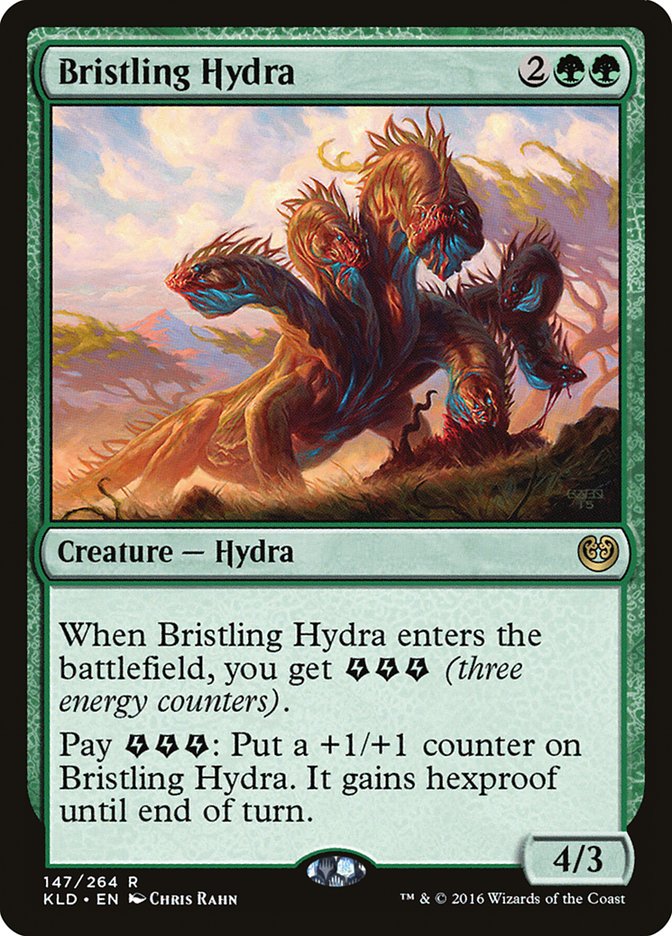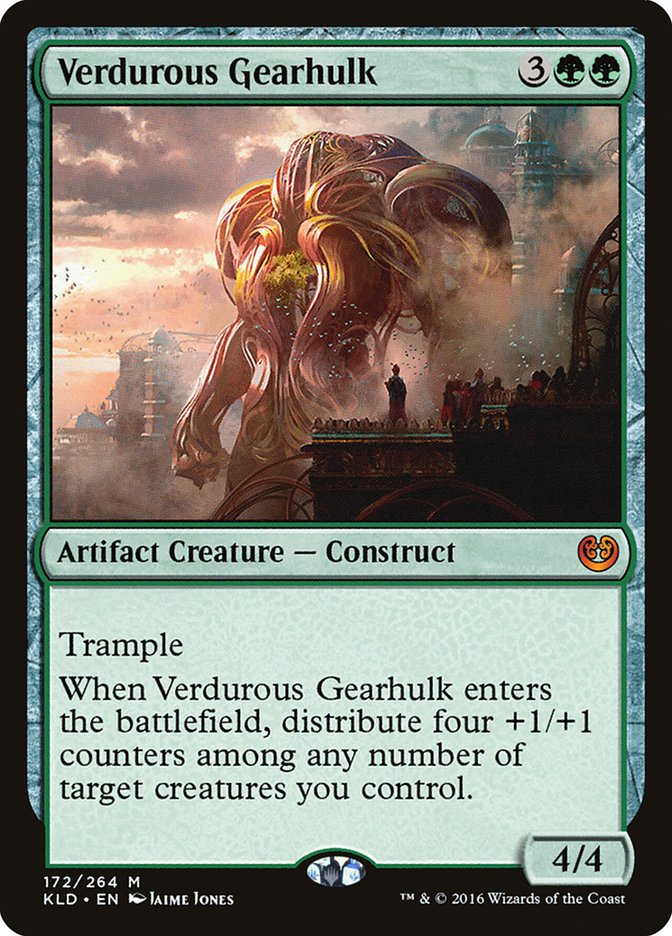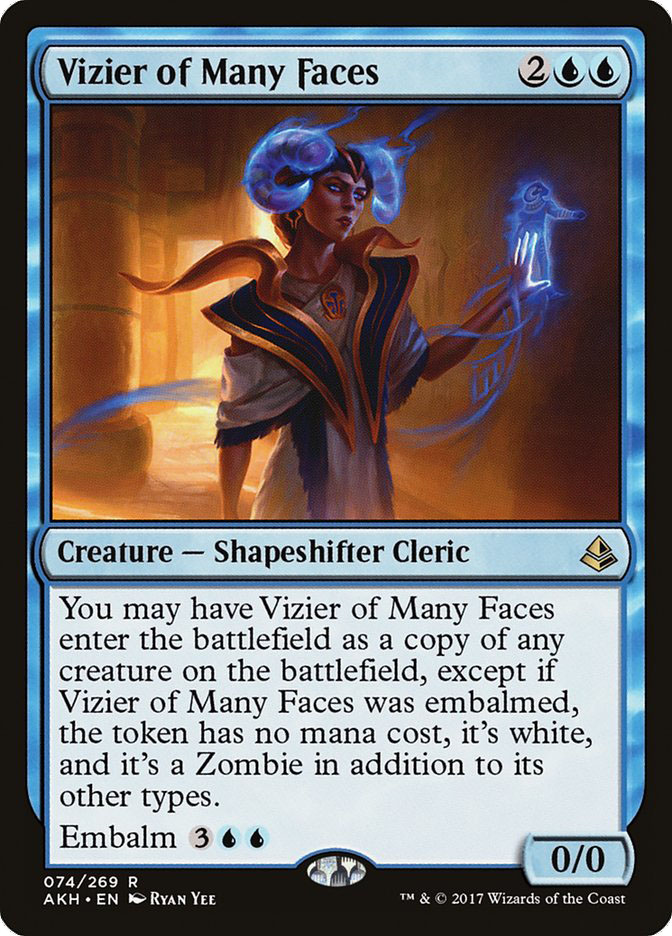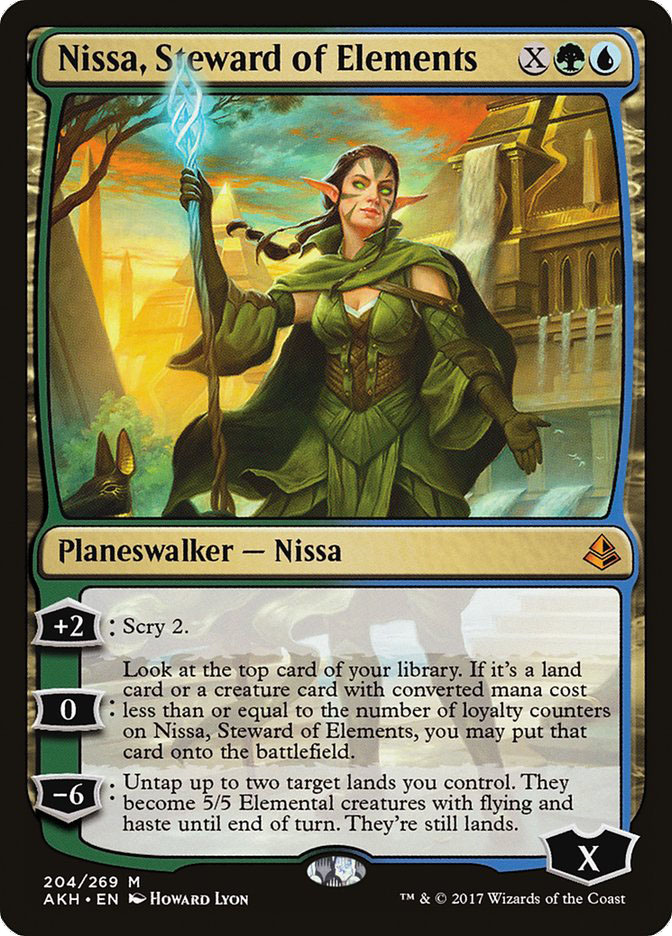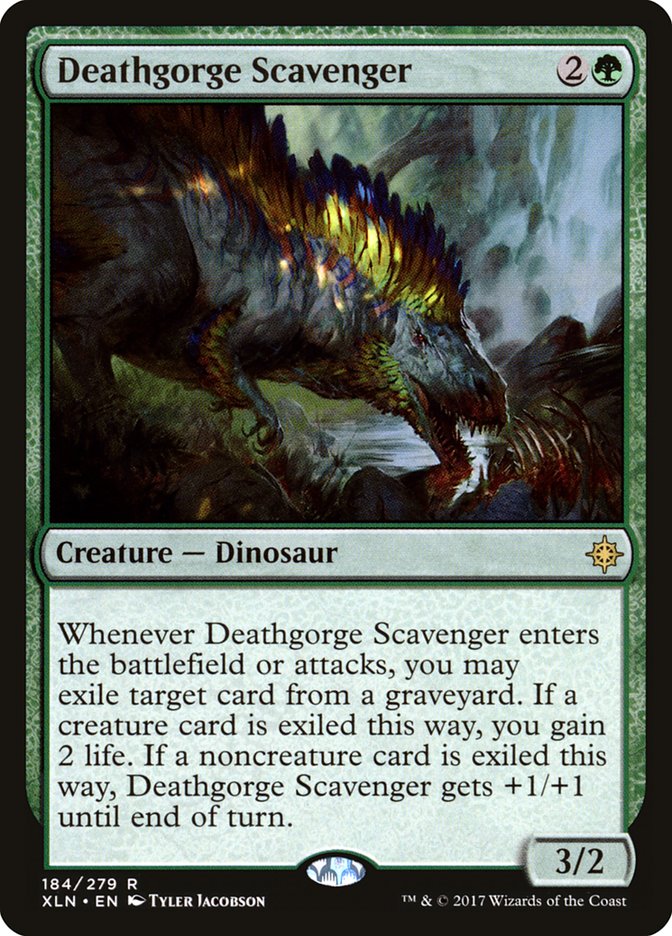Sultai Energy is the best deck you aren’t playing.
By a sheer stroke of luck (and let’s name that luck “Reid Duke”), I ended up working on Sultai for the World Magic Cup. My 8-1 record surprised even me. Sadly, that one loss came in the final round while playing for Top 8, but hey, I’m not complaining.
As always, playing in a tournament leads to me learning more about my deck, and I’d like to propose some changes to the deck I actually played.
My decklist for a Grand Prix or PPTQ would look like this:
Creatures (25)
- 4 Longtusk Cub
- 2 Bristling Hydra
- 4 Winding Constrictor
- 4 Glint-Sleeve Siphoner
- 4 Rogue Refiner
- 4 Walking Ballista
- 3 Hostage Taker
Lands (17)
Spells (18)

For the genesis on the deck and quick starter notes, check out my article from yesterday.
This is basically what I wanted to play at the World Magic Cup, but Reid insisted I play one copy of The Scarab God and Rishkar, Peema Renegade over the Bristling Hydras. The only other change is Negate over Spell Pierces, which were only there because of the Unified Standard rules.
Bristling Hydra provides a sticky threat in a Standard format full of spot removal. It’s also one of the few cards in the format that laughs at Glorybringer and Chandra, Torch of Defiance. Maintaining that traction is hugely important, as it means that Temur and Ramunap Red can’t punish you further with their best cards. The Scarab God does basically the same thing, but the extra mana is a killer sometimes.
Other than the somewhat strange addition of Bristling Hydra (and a 22nd land), I haven’t done anything too crazy to the decklist. The core is quite good.
The amount of interaction you play is certainly up for debate. I could see a world where you cut a Fatal Push from the maindeck or play zero Vraska’s Contempts, but I like this mix at the moment. You rarely feel like you’re flooding on interaction unless your opponent has a purely creatureless deck.
I’m interested in trying some spice, such as Verdurous Gearhulk in the maindeck and maybe one copy of Claim // Fame. Claim would be particularly helpful at sticking a Winding Constrictor or Glint-Sleeve Siphoner in the matchups where those cards matter a lot. It also gives you other opportunities to cast two spells on Turn 3, which is huge. If you get to Fame off an Aether Hub, even better. Verdurous Gearhulk is just a big animal that I could see dominating the battlefield against Temur and Ramunap Red. Is it better than The Scarab God, though? My guess is no.
Vizier of Many Faces would be excellent out of the sideboard, but I don’t think the mana can handle it, at least in large quantities. I could certainly tweak that mana, but how many hoops I’m willing to jump through will probably depend on whether or not Sultai gets more popular.
Nissa, Steward of Elements isn’t great, and it’s a placeholder. I could see playing another Duress in her spot.
I didn’t mulligan very many times throughout the tournament, although there are a couple of spots where maybe I should have mulliganed more aggressively, such as my first game against Wales. Regardless, I liked the 22nd land a lot.
The Secret to My Success
If anything, Sultai is great at tightening the noose. Sultai has sixteen two-drops, and while some scale into the late-game, it means your opponent will have more powerful cards than you on average. You’re a Fish deck, trying to get under your opponent and win by tempoing them out or by slowly cutting off their outs.
Cards like Rishkar, Peema Renegade add another layer to the deck, giving you free wins by creating a huge battlefield early, but given the context of Standard, Rishkar isn’t the correct card for the job. Being able to cut those sacred cows is very important.
Similarly, Deathgorge Scavenger is a card that is in most of the Sultai sideboards, but it never impressed me. Against the decks with Search for Azcanta or God-Pharaoh’s Gift, it’s reasonable, but nothing spectacular. As I noted last week, I decided I wanted Rogue Refiners instead of Deathgorge Scavengers against Ramunap Red, and I didn’t regret that in the slightest. There are some games where having some incidental life gain is nice, but not at the cost of having a three-drop that dies to Shock.
As I mentioned last time, one of the keys to my success was figuring out the proper sideboard plan against Ramunap Red. After a few different sets against Oliver Tomajko, I got a good handle on the matchup and settled on a plan that I stuck with throughout the entire tournament.
Sideboarding Guide
Ramunap Red, on the Draw
In:
Out:
Ramunap Red, on the Play
In:
Out:
Ramunap Red players will very rarely stay aggressive against energy strategies unless they’re on the MTG Mint Card build. Assuming they are transforming into a Chandra, Torch of Defiance / Glorybringer deck, it’s very beatable. While you have enough cards that help you stop early aggression, your biggest fear should be them staying hyper-aggro after you sideboard in cards like The Scarab God.
Taking out Glint-Sleeve Siphoners is kind of a hedge. It can be excellent on the play or in slower games, but most of the time it’s going to be a creature that doesn’t block effectively and is especially poor in games where you’re behind. If you get ahead, Sultai is typically good at cementing that advantage already, so Glint-Sleeve Siphoner isn’t necessary.
You absolutely need to do something in the first two turns against Ramunap Red, so mulligan accordingly.
Temur Energy, on the Play
In:
Out:
Temur Energy, on the Draw
In:
Out:
If your opponent is Four-Color Energy or simply has a slower version, likely with a pile of planeswalkers, consider sideboarding in some Negates or Duresses, depending on which seems better situated for the matchup. Duress is slightly better at protecting Glint-Sleeve Siphoner, which is one of the best ways for a smaller Energy deck to beat a bigger version.
Most of the time, you’ll be able to get under them by sticking a cheap threat and protecting it. You also have game going long with Hostage Taker and The Scarab God, but if they start resolving big spells on a clear battlefield, you’ll eventually lose, barring any Walking Ballista shenanigans.
I don’t think The Scarab God is particularly strong in this matchup, since it’s so easy for them to beat it with tempo from fliers, plus they also have Confiscation Coup. That said, it’s a huge threat and is better than the other cards lurking in your 75.
U/W Gift
In:
Out:
Longtusk Cubs are a fine source of pressure but don’t provide any added value against Fumigate and Fairgrounds Warden, so shaving at least some of them is correct.
Vizier of Many Faces would help this matchup too, but it’s already quite good.
Sultai Energy
In:
Out:
Very few things matter outside of Glint-Sleeve Siphoner, Hostage Taker, The Scarab God, and Walking Ballista. There are some games where beatdown from Longtusk Cub gets there, but those games are few and far between.
If you can, save The Scarab God until you have six mana so you can protect it with Blossoming Defense or at least have Fatal Push for their Hostage Taker.
What’s the Play?
Here are some fun situations that I took screenshots of while testing for the tournament. I mostly used them to fact check my work against Reid and Oliver in the situations that weren’t super-clear, and I think that’s a successful method. Not only did we agree on basically everything, but it also gave me more confidence going into the tournament that I was playing well and understood what was going on.
(Forgive the issues with card images not loading on Magic Online, as our Airbnb wifi wasn’t the best.)
#1
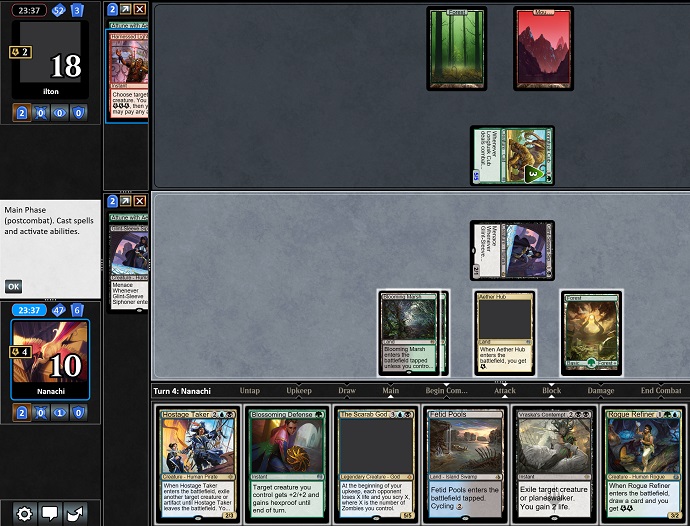
For this situation, let’s assume I hadn’t played my land quite yet.
My first Glint-Sleeve Siphoner was killed by Harnessed Lightning immediately, so I think it’s safe to say that my opponent doesn’t have another removal spell. If that’s the case, Hostage Taker seems like a fine way to get ahead.
If they somehow do have a removal spell, we could easily play around that by playing Vraska’s Contempt and saving the Hostage Taker for later (along with Blossoming Defense to protect it). In this spot, I think you can play around everything, even if it’s highly unlikely, and we probably should.
That said, I cast the Hostage Taker and won very easily.
#2
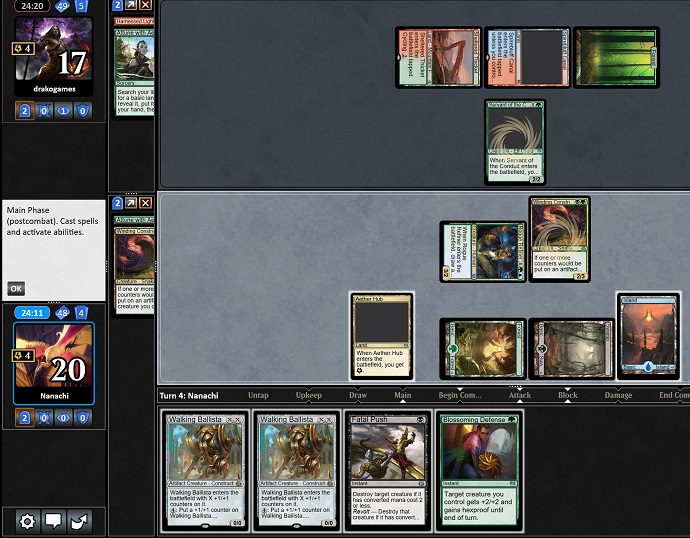
For this situation, let’s assume I didn’t cast the Winding Constrictor yet (even though I’m almost certainly doing that regardless of what my other play is).
The real question in this situation is how to best combat a Glorybringer. We could trade Walking Ballista for their Servant of the Conduit, which would delay Glorybringer by a turn. Being able to double spell this turn also makes Chandra, Torch of Defiance less effective against us.
Do we use a Walking Ballista or a Fatal Push, though? If we only had one copy of Walking Ballista, I think it would be easy to use the Fatal Push here. However, since we have two copies of Walking Ballista, it’s tempting to use one of them and save the Fatal Push, but what are you saving it for, exactly? There could be a situation where you want to remove a Whirler Virtuoso, but Walking Ballista arguably does a better job of that, especially considering how difficult it can be to enable revolt.
Obviously, if our Winding Constrictor dies, the Walking Ballistas get worse, but not by much. If Winding Constrictor dies, it’s not like your Fatal Push is going to be great, either, and it’s certainly not going to be better than Walking Ballista.
Situations like this force you to think about how valuable each card is in each matchup, and it’s why you should burn the Fatal Push here.
#3
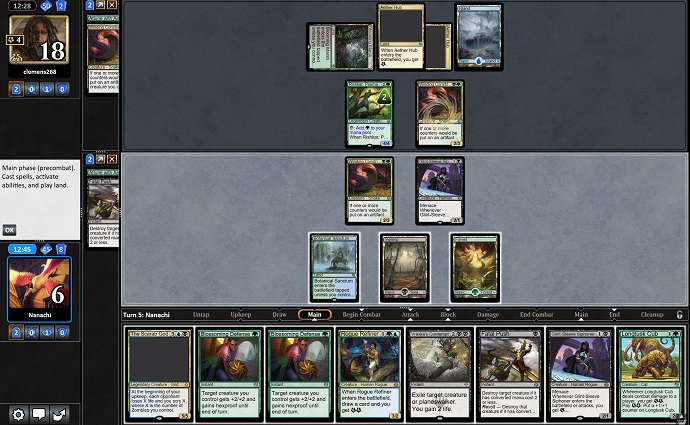
We’re mana screwed and on the defensive. Our opponent didn’t want to trade their Rishkar for our two creatures last turn, which makes me think The Scarab God is waiting in the wings. I also saw an Essence Scatter in the last game, which makes sense for my opponent to have in this spot.
One of the main goals for this turn should be to cast two spells. Jamming Rogue Refiner and trying to hit a land drop sort of makes sense, but if we miss again, it probably puts us too far behind. If it gets Essence Scattered, it would be a disaster.
If we decide to cast Longtusk Cub and Fatal Push, we should be casting the Longtusk Cub first to get more information. If it does get Essence Scattered, maybe we shouldn’t be attacking with Glint-Sleeve Siphoner, but we would probably want to Fatal Push the Winding Constrictor first if that’s the case.
Another option is using the two Blossoming Defenses and Fatal Push if they double block our Glint-Sleeve Siphoner. That would clear their battlefield and not walk into Essence Scatter, which could be nice.
I like casting Longtusk Cub, Fatal Pushing the Winding Constrictor, and then attacking with Glint-Sleeve Siphoner.
#4
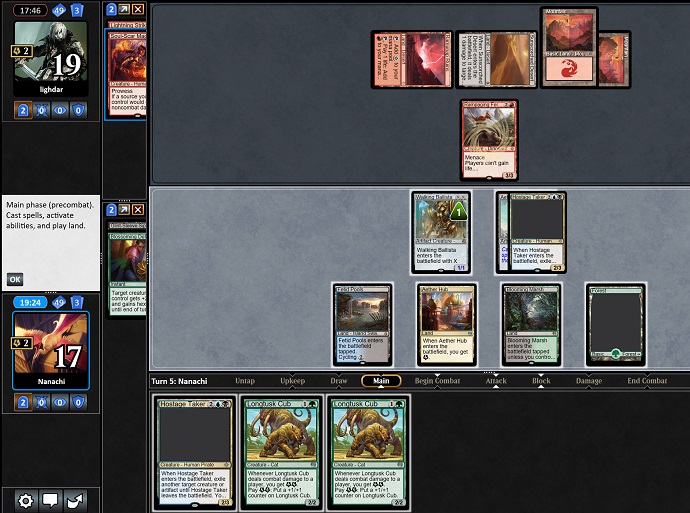
I was able to Hostage Taker an Aethersphere Harvester and got to untap, hooray! We’re not quite out of the woods yet, though.
The biggest concern is that my opponent has Glorybringer.
Casting both Longtusk Cubs is tempting, but because of Glorybringer, we need to cast the Aethersphere Harvester to block here.
#5
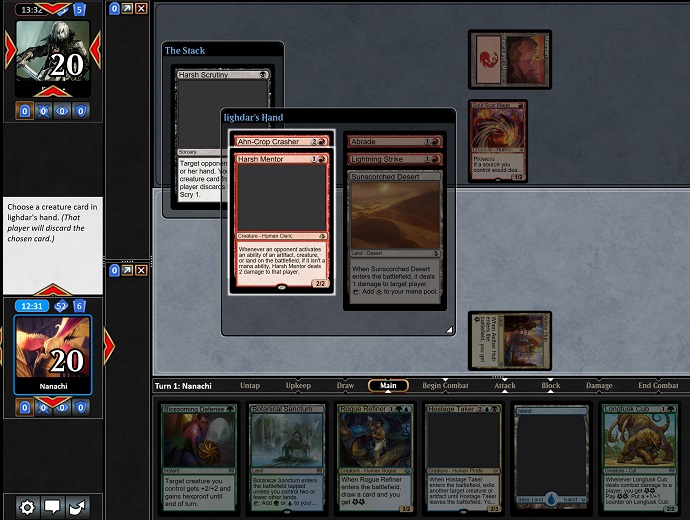
Yes, I was playing with Harsh Scrutiny. No, it wasn’t particularly great.
Do we take Harsh Mentor to stymie their curve or do we take Ahn-Crop Crasher to prevent a bigger hit later? In theory, we could play Longtusk Cub and have Blossoming Defense available, but they will probably Abrade it on our end step and either kill it with Lightning Strike on their turn or get in a hit with Crasher. That plan would also require us to draw a green source or something that makes energy and means we aren’t doing anything on Turn 2. Granted, they still need to draw a third land for Ahn-Crop Crasher, but that doesn’t seem particularly unlikely.
Assuming we want to curve out Longtusk Cub into Rogue Refiner, what’s the best play? I think it’s probably taking Harsh Mentor, but I could be wrong about that.
#6
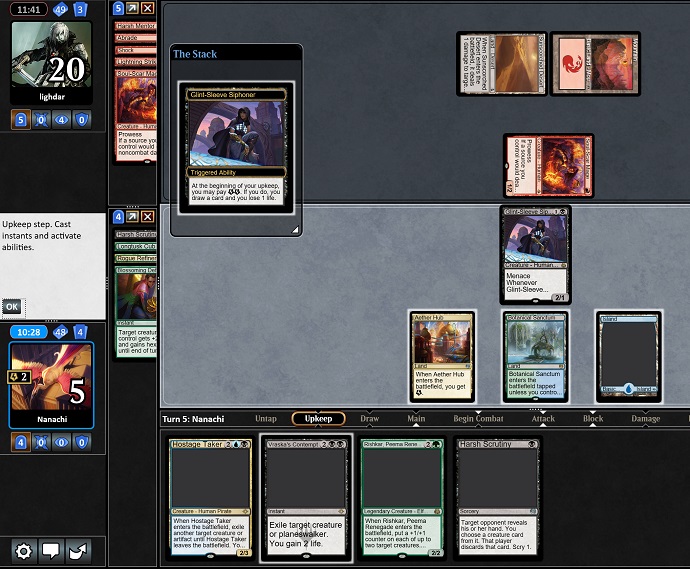
Pay a life or no?
I think the answer is yes because we need to lands to cast our spells. If we’re able to cast Vraska’s Contempt in a timely manner, everything should be fine either way. We are probably aren’t going to win the game by not peeling an extra card here.
#7
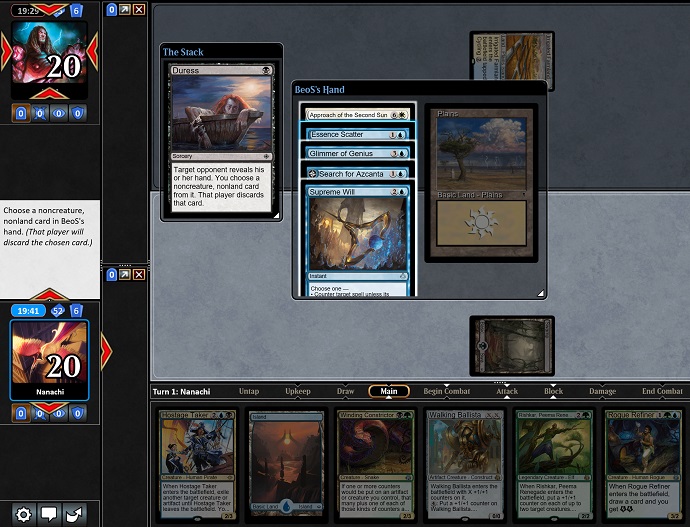
Our hand is clearly lacking green mana, so maybe this was a mulligan. Regardless, we’re here now, so what do we do?
Essence Scatter is going to be huge, so taking that could help us establish a clock, assuming we draw into green mana in time. However, they are land light and Search for Azcanta is going to ramp them up to Approach of the Second Sun. We might not be able to clock our opponent in time, especially given our mana issues.
Given that, the best course of action seems like taking Search for Azcanta and trying to slow them down.
#8
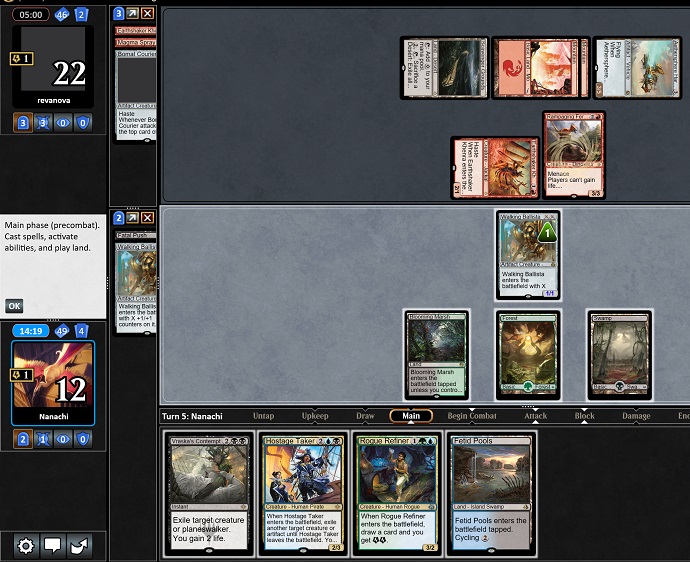
Okay, okay, this was just a very tilting screenshot.
#9
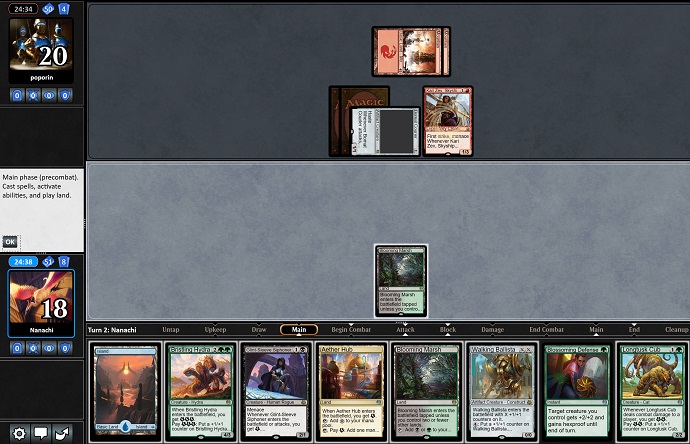
I like Walking Ballista on Turn 2 with the plan to block Ragavan and shoot the Bomat Courier. Longtusk Cub can be protected with Blossoming Defense on Turn 3 and Bristling Hydra should help us stabilize on Turn 4.
If we didn’t have the Bristling Hydra in hand, I’d be more interested in trying to save the Walking Ballista for Turn 4, which would probably lead to me playing the Glint-Sleeve Siphoner on Turn 2 and taking a bunch of damage.
#10
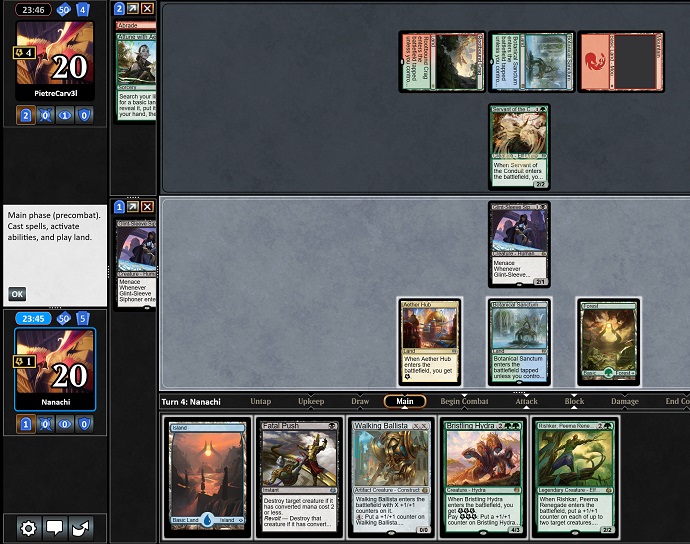
How many hoops are you willing to jump through in order to stop the impending Glorybringer?
Rishkar, attack, and Fatal Push the Servant of the Conduit isn’t the worst play, but it leaves us unable to draw a card next turn with Glint-Sleeve Siphoner. Casting Bristling Hydra would be fine, but we’re probably not drawing a card with Glint-Sleeve Siphoner if they have a Glorybringer in that situation.
I like Rishkar and Fatal Push here.
#11
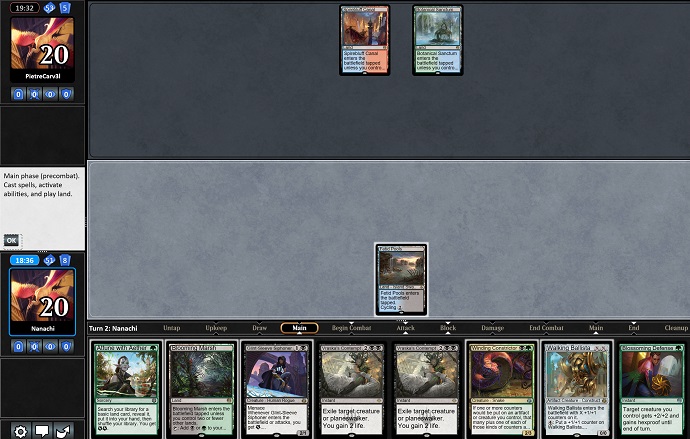
This is basically what Energy mirrors come down to: how to best maneuver in order to make their cards matter less.
I think it’s safe to say that our opponent has a removal spell. Maybe they simply have some three-drops, but I sort of doubt that. Even if they don’t have one, what’s our best case scenario here? We can’t draw a card with Siphoner next turn, and Winding Constrictor isn’t threatening much.
Realistically, the best chance of winning this game is set up Glint-Sleeve Siphoner plus Blossoming Defense on Turn 3. I don’t think that’s what I ended up doing this game, but I firmly believe it was wrong!
The Hostage Taker
The real thinker of a play actually came during the World Magic Cup. At the time, it seemed pretty obvious, even though it’s one of those plays that you know isn’t necessarily going to end well. Watching the VOD, it was clear Twitch chat didn’t agree with the play. While you should never put too much stock into what Twitch chat has to say, I’ve literally never seen people disagree so vehemently with a play I’ve made (unless it was truly terrible).
Here’s the situation:
It’s Game 3 and you’re playing for Top 8 of the World Magic Cup against Wales, a team you’ve been cheering for the entire weekend but who have already beaten your team earlier in the pod.
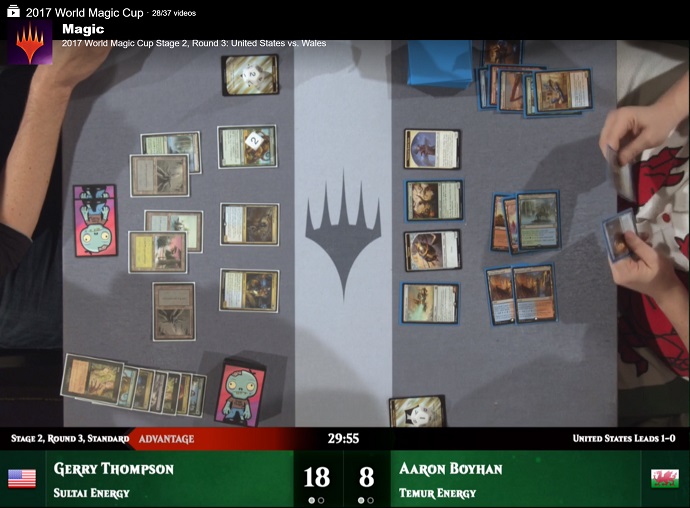
What do you do?
Option 1: Fight The Scarab God versus The Scarab God and see who wins. Note that my Vraska’s Contempts are in my sideboard and I have three Walking Ballistas left in my deck. My opponent also has a mana advantage and two excellent cards in hand, plus an Aethersphere Harvester on the battlefield. That seems like a fight I was going to lose.
Option 2: Cast Hostage Taken on their Vizier of Many Faces token that is copying The Scarab God and attack with your two potential 5/5s. They will likely cast the other Vizier from their hand, copying your Hostage Taker and stealing you’re the Scarab God. If they get to untap and cast The Scarab God, you’re going to be in a bad position, but arguably it’s the same position as you would be in had you not cast Hostage Taker, except they’re at a higher life total and don’t have an Aethersphere Harvester.
My Vraska’s Contempts were in the sideboard, which honestly might be the big mistake here. Aaron’s deck contained one Blossoming Defense, some Revolutionary Rebuffs, Confiscation Coup, some removal spells, and Skysovereign, Consul Flagship, so sideboarding in two copies of Duress seemed fine. Obviously I never want to draw two in a single game, but I did.
As you probably know, I went with Option 2, and Twitch chat did not like that plan at all. Frankly, most of them didn’t seem to consider the opposite line of doing nothing and what would happen as a result. Regardless, I should have attacked before making my decision. If Aaron wants to trade off his The Scarab God token, then there’s no need to cast Hostage Taker, which saves my The Scarab God from getting stolen.
If he trades off the Aethersphere Harvester, I can entertain the idea of trying to win the God versus God fight, even though I’m a huge dog. Maybe I can The Scarab God Aaron’s Whirler Virtuoso and whittle him down with The Scarab God and a Thopter, but he can always Vizier the Whirler that I’d get back, so I doubt it.
The best-case scenario is that Aaron blocks exactly the same way, loses the Harvester, and we The Scarab God his Whirler Virtuoso, but it seems unlikely that he would go to three if he knows I can take his Whirler also. Regardless, I should have attacked first.
Do you disagree with any of my plays? Let me know in the comments!


